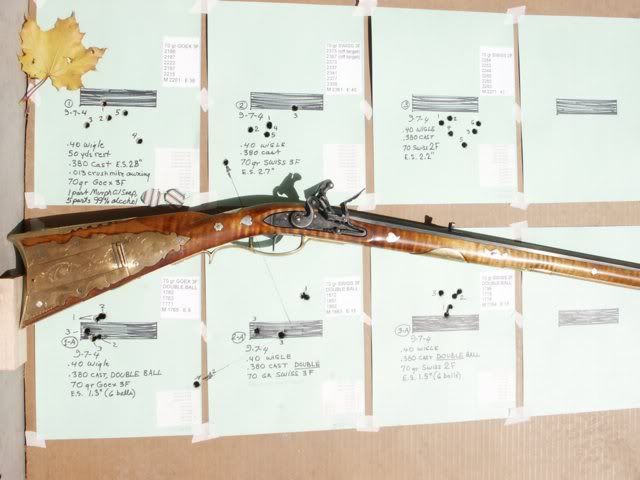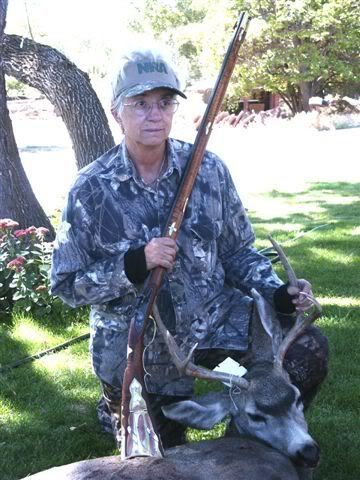paulvallandigham
Passed On
- Joined
- Jan 9, 2006
- Messages
- 17,538
- Reaction score
- 81
As you have figured out, shoot a DOUBLE BALL- rather than two bullets is not going to cause problems in a well made gun. I know you are shooting Lyman rifles, and you should have no problems with that gun.
You do want a new nipple on any caplock, so that the hammer doesn't blow back on your sending shards of spent cap into your face.
And, the warning about the problem of dieseling when you load the second PRB will become immediately apparent when you try loading a second PRB! :grin: :bow: But, once you seat the second Ball on the top, it should be no problem. The recoil will increase, but against a Grizzly at social distances, I don't think you will notice! :shocked2: :haha:
BTW, from the old biographies I have read of Mountain Men, the situation you describe- finding fresh sign of a Bear and immediately putting a second Ball down your barrel is EXACTLY how it was done in the early 19th century, and obviously for the same reason.
There is no question that a double ball load, at close range will put a lot of Whomp on any bear. There may be a slight reduction in velocity from pushing the two balls, but at short ranges, the Bear won't feel the difference. Its the mass of the balls that drives them deep.
I know that you are shooting primarily .54, and .58 caliber guns, and you should, considering where you live and hunt.
Down here on the flats, I can't think of any game that would require a double ball load, save perhaps wild boar that go over 500 lbs. Most of the black bear taken are under 300 lbs, and are shot from elevated stands over bait, where hunter survival is usually not a problem. If I were going to hunt either large bears, or wild boar, I would recommend using conicals, in .45 or .50 caliber guns. Even in a .54, a RB might not be enough to drop them. That is where using Double Balls makes sense.
A friend shot a wild boar in the chest with his .62 caliber rifle using a PRB( 325 grains plus/minus) and the boar did not drop. He had reloaded his gun, and mounted it to his shoulder just as the boar finally dropped and died. It had not moved an inch since he shot it. It went over 300 lbs. The ball went all the way through the boar, cutting through the Ham, and was found under the skin at the rear of the back leg muscle(Ham).
I have used that weight of ball( 325 grs.) as my benchmark, personally, when deciding if a double Ball is needed. Two .45 cal. balls weighing 125 grains each barely equals ONE round ball in .54 caliber at 230 grains. I know Dan'l shot a lot of bear with a .45, according to legend, but I would be more comfortable with a .54 that I can double ball, thank you, as a minimum caliber to take bear hunting. :hmm: :surrender: :hatsoff:
You do want a new nipple on any caplock, so that the hammer doesn't blow back on your sending shards of spent cap into your face.
And, the warning about the problem of dieseling when you load the second PRB will become immediately apparent when you try loading a second PRB! :grin: :bow: But, once you seat the second Ball on the top, it should be no problem. The recoil will increase, but against a Grizzly at social distances, I don't think you will notice! :shocked2: :haha:
BTW, from the old biographies I have read of Mountain Men, the situation you describe- finding fresh sign of a Bear and immediately putting a second Ball down your barrel is EXACTLY how it was done in the early 19th century, and obviously for the same reason.
There is no question that a double ball load, at close range will put a lot of Whomp on any bear. There may be a slight reduction in velocity from pushing the two balls, but at short ranges, the Bear won't feel the difference. Its the mass of the balls that drives them deep.
I know that you are shooting primarily .54, and .58 caliber guns, and you should, considering where you live and hunt.
Down here on the flats, I can't think of any game that would require a double ball load, save perhaps wild boar that go over 500 lbs. Most of the black bear taken are under 300 lbs, and are shot from elevated stands over bait, where hunter survival is usually not a problem. If I were going to hunt either large bears, or wild boar, I would recommend using conicals, in .45 or .50 caliber guns. Even in a .54, a RB might not be enough to drop them. That is where using Double Balls makes sense.
A friend shot a wild boar in the chest with his .62 caliber rifle using a PRB( 325 grains plus/minus) and the boar did not drop. He had reloaded his gun, and mounted it to his shoulder just as the boar finally dropped and died. It had not moved an inch since he shot it. It went over 300 lbs. The ball went all the way through the boar, cutting through the Ham, and was found under the skin at the rear of the back leg muscle(Ham).
I have used that weight of ball( 325 grs.) as my benchmark, personally, when deciding if a double Ball is needed. Two .45 cal. balls weighing 125 grains each barely equals ONE round ball in .54 caliber at 230 grains. I know Dan'l shot a lot of bear with a .45, according to legend, but I would be more comfortable with a .54 that I can double ball, thank you, as a minimum caliber to take bear hunting. :hmm: :surrender: :hatsoff:







